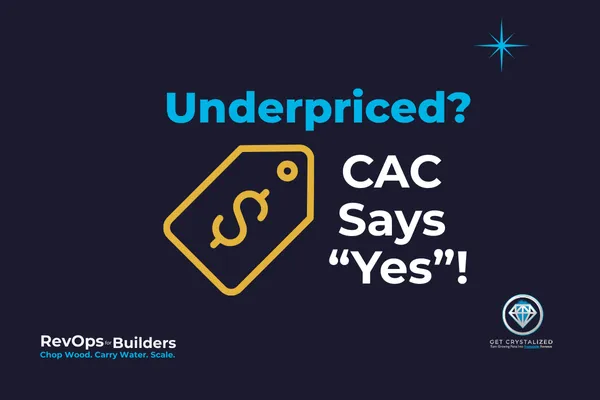
How Customer Acquisition Cost (CAC) Shapes Pricing Strategy
Underpriced? How CAC Shapes Product & Service Pricing
Why CAC Belongs in Every Pricing Conversation
Many founders set prices based on what feels fair, what competitors charge, or what customers say. But here’s the truth: if you don’t use CAC, you’re flying blind.
CAC (Customer Acquisition Cost) = how much it costs to win one customer.
Your price has to cover CAC, your costs, and still leave profit.
If not, every new customer could actually cost you money.
So the better question isn’t “What should I charge?” — it’s “How does CAC guide pricing across my whole business system?”
Founder Reflection: What I Learned the Hard Way
I used to wonder why I should pay for ads when social media content is “free.” Influencers like Gary Vee talk about this all the time.
But here’s what I discovered: even with paid ads, conversions don’t happen unless you have three things:
A solid offer
A tested message
Customers to validate it
I once ran Facebook ads without an offer, a clear message, or a system to back it up. I may as well have set that money on fire.
What I learned is that this whole process is an experiment. As founders, we’re constantly working to understand the levers in our business that actually drive growth. That part doesn’t always make it into the influencer highlight reels.
I had to learn this the hard way — but you don’t have to. That’s why RevOps for Builders exists: to shine a light on the metrics and systems that let you scale with a solid foundation.
Marketing: Costs That Push CAC Up or Down
Marketing is your visibility engine — ads, content, events, referrals.
Every dollar spent here changes CAC.
Weak targeting = CAC rises and you feel pressure to discount.
Smart targeting = CAC drops and you keep pricing power.
Example (Services):
Two consultants both charge $1,000 for a strategy session.
Consultant A spends $800 to land the client. Profit = $200.
Consultant B spends $200 to land the client. Profit = $800.
Example (Products):
An e-commerce store sells a $50 product.
If CAC = $40 → only $10 left to cover product cost + profit.
If CAC = $10 → $40 margin available.
Takeaway: Pricing power begins with efficient marketing. If CAC is bloated, you’ll always feel underpriced.
Sales: Designing Prices That Recover CAC
Sales is the conversion engine that turns leads into customers.
If CAC = $500, your offer must recover it within the payback period.
You can use bundles, tiers, or deposits to make CAC work in your favor.
Example (Services):
A consultant spends $500 to get a new client.
At $400 per engagement → loss.
At $1,200 with a retainer option → CAC covered quickly, profit secured.
Example (Products):
A SaaS company has CAC of $300.
At $50/month with average customer drop-off at 4 months → $200 revenue → loss.
At $100/month with 30% upgrading to a $200 plan → average $350 revenue → profit.
Takeaway: Without CAC clarity, you may sell at a loss and not even realize it.
Onboarding: Retention Protects CAC Payback
Onboarding and early customer experience matter as much as the sale.
Even if pricing looks good, customer drop-off can wreck the math.
Example (Products):
If it costs $400 to win a customer who buys a $50 item, you need 8 repeat purchases just to break even. If customers only buy once, you lose money.
Example (Services):
If it costs $400 to land a client and you charge $1,200, you’re profitable on the first project. But if they cancel before you deliver or never renew, that CAC doesn’t pay back as planned.
Takeaway: Don’t cut price. Fix onboarding and early engagement. Pricing only works if customers stick around long enough to cover CAC.
Retention: Expanding LTV Reduces CAC Pressure
Retention is where pricing becomes a growth lever.
Longer retention = higher lifetime value (LTV).
Higher LTV makes CAC less of a burden.
Upsells and cross-sells grow revenue from the same CAC.
Example (Products):
If CAC = $20 and a customer only buys once at $25 → slim margin.
If the same customer buys 5 times over the year → $125 revenue, far healthier.
Example (Services):
If CAC = $500 and you sell a one-time $500 workshop → break even.
But if the same client renews for $1,500 coaching → LTV = $2,000. Now your CAC:LTV ratio = 1:4 (very healthy).
Takeaway: Retention turns CAC from a cost problem into an advantage.
Guardrails for Founders
Minimum Price: Must cover CAC + costs.
Payback Goal: Recover CAC within 3–6 months (subscription/product) or first sale (high-ticket service).
LTV:CAC Ratio: Aim for 3–5x.
System Check: Look at marketing, sales, onboarding, and retention before changing prices.
How the Streamline & Scale™ Framework Fits
At Get Crystalized Agency™, we built the Streamline & Scale™ Framework to help founders move beyond duct-taped tools and guesswork. It connects the three investor-ready metrics — CAC, LTV, and Payback Period — across the full customer journey: marketing, sales, onboarding, and retention.
That’s why CAC isn’t just a number. It’s part of a system. When your systems work together, pricing decisions stop being a gamble and start fueling repeatable revenue and long-term growth.
Want to see where your business stands? Grab the free Scale-Ready Systems Checklist™. It maps your journey across 16 scale levers and shows whether your systems are fragile, duct-taped, almost ready, or investor-ready.
